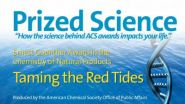(Press-News.org) A new study from researchers at North Carolina State University sheds light on how a technique that is commonly used for making single-metal nanoparticles can be extended to create nanoparticles consisting of two metals – and that have tunable properties. The study also provides insight into the optical properties of some of these nanoparticles.
Tuning the optical properties of nanoparticles is of interest for applications such as security technology, and for use in making chemical reactions more efficient – which has multiple industrial and environmental applications.
The researchers created core/shell nanoparticles with a gold core and silver shell, as well as alloy nanoparticles, which mix the gold and silver. The researchers also characterized the optical properties of these nanoparticles. "Silver and gold have unique optical properties arising from their specific interactions with the electric field of light," says Dr. Joe Tracy, an assistant professor of materials science and engineering at NC State and co-author of a paper describing the study. "By manipulating the ratio of the metals, and whether the nanoparticles have core/shell or alloy structures, we can alter their optical properties with control."
The researchers synthesized the nanoparticles using a technique called "digestive ripening." The technique has been used to create single-metal particles for approximately a decade, but there have been limited studies of core/shell and alloy nanoparticles created using digestive ripening. However, the comprehensive nature of this study may make it more common.
"This study, along with related work by others, shows that digestive ripening is a viable method for creating multi-component metal nanoparticles. We used gold and silver, but the same principles would likely apply to other metals," Tracy says. "Our detailed evaluation of this synthetic approach should help other researchers explore other kinds of binary metal nanoparticles."
Digestive ripening relies on the use of ligands, which are small organic molecules with parts that bond directly to metals. The ligands are usually anchored to the metal cores of the nanoparticles and prevent the nanoparticles from clumping together, which allows them to be suspended in solution. Digestive ripening occurs when the ligands are able to transport metal atoms from the core of one nanoparticle to another – resulting in a more homogenous size distribution among the nanoparticles.
The researchers used digestive ripening to create a solution of gold nanoparticles of similar size. When they introduced silver acetate into the solution, the ligands transported silver atoms to the surfaces of the gold nanoparticles, resulting in nanoparticles with gold cores and silver shells.
Researchers then transferred the nanoparticles into a second solution, containing a different ligand. Heating this second solution to 250 degrees Celsius caused the metals to diffuse into each other – creating nanoparticles made of a gold-silver alloy.
The researchers also created gold-silver alloy nanoparticles by skipping the shell-creation step, introducing silver acetate into the second solution, and raising the temperature to 250 degrees Celsius. This "shortcut" method has the benefit of simplifying control over the gold-to-silver ratio of the alloy.
INFORMATION:
The paper, "Synthesis of Au(core)/Ag(shell) Nanoparticles and their Conversion to AuAg Alloy Nanoparticles," was published online Dec. 13 by the journal Small. The research was funded by the National Science Foundation and NC State. The lead author of the paper is Matthew Shore, who was an undergraduate at NC State when the research was done. Co-authors include Tracy, NC State Ph.D. student Aaron Johnston-Peck, former NC State postdoc Dr. Junwei Wang, and University of North Carolina at Chapel Hill assistant professor Dr. Amy Oldenburg.
Study improves understanding of method for creating multi-metal nanoparticles
2010-12-16
ELSE PRESS RELEASES FROM THIS DATE:
New American Chemical Society Prized Science video on 'red tide' shellfish poisoning
2010-12-16
WASHINGTON, Dec. 15, 2010 — The quest to cure a terrible form of food poisoning caused by population explosions of algae that stain the water red and produce a potent toxin is the topic of a new episode in the American Chemical Society (ACS) Prized Science video series.
Entitled "Taming the Red Tides," the high-definition video, released today, focuses on Michael Crimmins, Ph.D., winner of the 2010 Ernest Guenther Award in the Chemistry of Natural Products. Crimmins, a chemist at the University of North Carolina in Chapel Hill, studies brevetoxin A, a poison produced ...
Study supports gluten-free diet in potential celiac disease patients
2010-12-16
Findings from a new study of 141 adults add to an ongoing medical debate over which patients with symptoms of celiac disease should go on a gluten-free diet. Published in ACS' Journal of Proteome Research, the study concludes that people currently diagnosed as "potential" celiac disease patients and not advised to follow a gluten-free diet may not be "potential" patients at all. Rather, the scientists found that these patients have the same distinctive metabolic fingerprint as patients with full-blown disease who do benefit from gluten-free diets.
In the study, Ivano ...
Does fluoride really fight cavities by 'the skin of the teeth?'
2010-12-16
In a study that the authors describe as lending credence to the idiom, "by the skin of your teeth," scientists are reporting that the protective shield fluoride forms on teeth is up to 100 times thinner than previously believed. It raises questions about how this renowned cavity-fighter really works and could lead to better ways of protecting teeth from decay, the scientists suggest. Their study appears in ACS' journal Langmuir.
Frank Müller and colleagues point out that tooth decay is a major public health problem worldwide. In the United States alone, consumers spend ...
Toxic toy crisis requires fresh solutions
2010-12-16
Manufacturer recalls of toys, promotional drinking glasses, and other children's products constitute an ongoing "toxic toys crisis" that requires banning potentially harmful ingredients in these products and other changes in policy and practices. That's the conclusion of a new analysis in ACS' journal Environmental Science & Technology.
Monica Becker, Sally Edwards and Rachel Massey note that in June the United States government recalled 12 million promotional drinking glasses sold at a fast-food restaurant chain because the painted coating contained cadmium, a toxic ...
Preteen conduct problems leads to teenage serious violence and delinquency
2010-12-16
Montreal, December 15, 2010 – Conduct disorders in preteens are predictive of eventual teenage serious violent and delinquent behavior, according to a new study from the Université de Montréal. The findings, published in this month's issue of Journal of Child Psychology and Psychiatry, have implications for concerned parents.
Preteens who steal, destroy property, fight and bully are six times as likely to sell illicit drugs, nine times as likely to join a gang, 11 times as likely to carry a weapon and eight times as likely to be arrested as a future teenager, according ...
Cilantro ingredient can remove foul odor of holiday chitlins
2010-12-16
With chitlins about to make their annual appearance on Christmas and New Year's Day menus, scientists have good news for millions of people who love that delicacy of down-home southern cooking, but hate the smell. They are reporting the first identification of an ingredient in cilantro that quashes the notoriously foul odor of chitlins — a smell known to drive people from the house when chitlins are cooking. Their report appears in ACS' Journal of Agricultural and Food Chemistry.
Yasuyoshi Hayata and colleagues note that chitlins — hog large intestines — are infamous ...
Bacterial life on and in humans orchestrates health and disease
2010-12-16
A mounting tide of scientific evidence suggests that the old adage from Aesop's fables — "You are known by the company you keep" — also applies to the trillions of microscopic bacteria and viruses that live on the human body. Humanity's invisible but constant companions — more bacteria hang out on the palms of your hands than there are people on Earth — is the topic of an article in the current edition of Chemical & Engineering News (C&EN), ACS' weekly newsmagazine.
C&EN Associate Editor Sarah Everts notes in the article that the astonishing diversity of microbes inhabiting ...
New discoveries make it harder for HIV to hide from drugs
2010-12-16
The virus that causes AIDS is chameleon-like in its replication. As HIV copies itself in humans, it constantly mutates into forms that can evade even the best cocktail of current therapies. Understanding exactly how HIV cells change as they reproduce is key to developing better tests and treatments for patients.
In the Journal of Biological Chemistry and Nature Structural & Molecular Biology, MU microbiologist and biochemist Stefan Sarafianos, PhD, reveals new findings that shed light on how HIV eludes treatment by mutating. His discoveries provide clues into HIV's mechanisms ...
Atomic weights of 10 elements on periodic table about to make an historic change
2010-12-16
For the first time in history, a change will be made to the atomic weights of some elements listed on the Periodic table of the chemical elements posted on walls of chemistry classrooms and on the inside covers of chemistry textbooks worldwide.
The new table, outlined in a report released this month, will express atomic weights of 10 elements - hydrogen, lithium, boron, carbon, nitrogen, oxygen, silicon, sulfur, chlorine and thallium - in a new manner that will reflect more accurately how these elements are found in nature.
"For more than a century and a half, many ...
Soft substrate promotes pluripotent stem cell culture
2010-12-16
CHAMPAIGN, Ill. — University of Illinois researchers have found a key to keeping stem cells in their neutral state: It takes a soft touch.
In a paper published in the journal PLoS One, the researchers demonstrated that culturing mouse embryonic stem cells (mESCs) on a soft gel rather than on a hard plate or dish keeps them in their pluripotent state, a ground state with the ability to become any type of tissue. The soft substrate maintains homogeneous pluripotent colonies over long periods of time – without the need for expensive growth chemicals.
"This has huge applications ...


